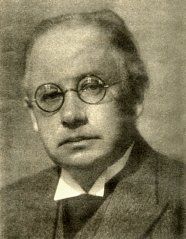Hans F. Schaub
Hans Ferdinand Schaub was born on 22 September 1880 in Frankfurt am Main (Germany). His father was a businessman, but his mother was a good piano amateur that led Hans F. Schaub to the music. He first studied at the Hoch'sche Konservatorium in Frankfurt am Main under Iwan Knorr and Alfred Mendelssohn. After a short intermezzo as chorus master in Bingen and as a lecturer for music theory in Wroclaw Hans F. Schaub continued his studies in Berlin. There he studied composition under Engelbert Humperdinck.
Then Hans F. Schaub worked as a composer, teacher and writer. In the first years after his studies he was the editor of the "Deutsche Musikerzeitung" and active in the musical education reform movement around Anna Morsch. In 1916 he moved to Hamburg and worked there as the chief music editor of the "Hamburgischer Correspondent" as well as lecturer at the Vogtschen Konservatorium until 1934. He then quit these activities and started to work as a teacher at the Curschmann Gymnasium and the Bismarck-Oberrealschule.
Hans Ferdinand Schaub died on 12 November 1965 in Hanstedt (Nordheide), a small town near Hamburg.
Beside his work as a teacher and writer Hand Ferdinand Schaub composed music since his early days. His first serious composition - an "Andante religioso for cello and piano op.1" - was composed in 1895 at the age of 15. His first compositions found immediate success and were performed by renowned artists. His "Capriccio for violin and piano op.4" was for example premiered by Henry Marteau, his "Three intermezzi for small orchestra op.5" premiered by conductor Max von Schillings in 1914.
In my possession is the autograph manuscript of the full score for "Passacaglia and Fugue for large orchestra op.10". The work was composed in 1934 and is considered as the magnum opus of Hans Ferdinand Schaub. It was premiered on 22 September 1935 with the Berlin Philharmonic Orchestra under Peter Raabe at the "Berliner Tonkünstlerfest" of the Allgemeiner Deutscher Musikverein and received umpteen performances in the next years.
In 1938 the "Zeitschrift für Musik" dedicated an issue especially to Hans F. Schaub. The "Passacaglia and Fugue" received an detailed analysis in which one could read:
"With this work Hans F. Schaub stands in the height of his small (due to adverse conditions) but distinctive compositional output. [..] Right at the beginning, within the first three variations, the writing for the strings impresses with noble patina. The manner in which the dignified rise of the individual melodic lines of the strings alternate and is brought to climax, belongs to the most virtuosic brainchild of what the composer has ever created."
(Zeitschrift für Musik, volume 105, issue 12, page 1311)
